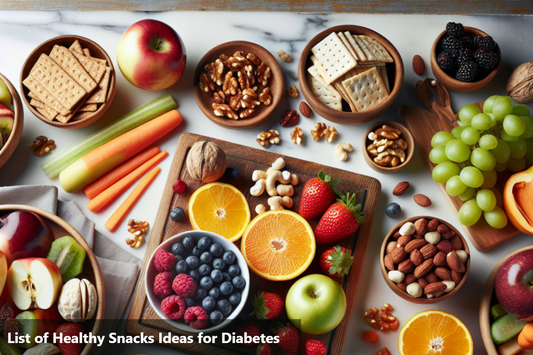Poha, or flattened rice, is a popular Indian breakfast dish known for its lightness and versatility. It is low in calories, fat, and cholesterol, making it a suitable option for individuals with diabetes.
To make poha diabetes-friendly, add veggies like peas, carrots, and peppers for extra nutrition. Using less oil and adding protein-rich toppings like peanuts or tofu can enhance its health benefits.
Remember to watch portion sizes and ingredients for a balanced and nutritious diabetes-friendly meal.
Nutritional benefits of poha
Poha, also known as flattened rice, offers a myriad of nutritional benefits that can be advantageous for individuals managing diabetes. This popular Indian breakfast dish is not only delicious but also rich in essential nutrients crucial for overall health.
Nutrient |
Amount per 100g |
|---|---|
Calories |
350 kcal |
Carbohydrates |
76.9 g |
Protein |
6.4 g |
Fat |
0.1 g |
Fiber |
1.3 g |
Iron |
1.5 mg |
Calcium |
10 mg |
Vitamin B1 (Thiamine) |
0.1 mg |
Vitamin B2 (Riboflavin) |
0.1 mg |
Vitamin B3 (Niacin) |
1.5 mg |
Vitamin B6 |
0.1 mg |
Folate (Vitamin B9) |
40 mcg |
Gluten-Free: Poha is naturally gluten-free, making it suitable for individuals with gluten intolerance or celiac disease.
Quick and Easy to Prepare: Poha is convenient to prepare and can be customized with various ingredients like vegetables, nuts, and spices to enhance its nutritional profile and flavor.
Glycemic index of poha variants
The glycemic index (GI) of poha can vary depending on factors such as the processing method, type of rice used, and additional ingredients. Generally, poha has a moderate to high GI due to its carbohydrate content. However, it tends to have a lower GI compared to some other rice-based foods because it undergoes processing, which can affect its digestibility.
Here are approximate glycemic index values for different poha variants:
White Rice poha: White rice poha typically has a higher GI compared to other variants due to its refined nature. Its GI may range from 65 to 75.
Brown Rice Poha: Brown rice poha is made from unpolished or minimally polished brown rice, which retains more fiber and nutrients compared to white rice. Therefore, its GI is lower than that of white rice poha, usually ranging from 50 to 65.
Red Rice Poha: Red rice poha is made from red rice, which contains antioxidants and fiber. Its GI is similar to brown rice poha and may range from 50 to 65.
Mixed Grain Poha: Some variants of poha are made by combining different grains, such as rice, millets, or quinoa. These mixed grain poha varieties tend to have a lower GI compared to poha made solely from rice, typically ranging from 45 to 60.
Incorporating poha into a diabetes-friendly diet
Choose Whole Grain Poha: Go for whole grain poha like brown rice poha or mixed grain poha. They have more fiber and are better for controlling blood sugar than white rice poha. The fiber in whole grain poha slows down how quickly your body absorbs sugar, which helps keep your blood sugar levels steady.
Control Portion Sizes: Be mindful of how much poha you serve yourself. Stick to the recommended amount, which is typically around ½ to 1 cup of cooked poha per meal, based on your dietary needs and blood sugar goals.
Add Protein: Eating poha with a good source of protein can help keep your blood sugar stable and make you feel full. Try adding tofu, eggs, lean meats, or legumes to your poha to up the protein.
Include Vegetables: Make your poha even healthier by tossing in veggies like spinach, bell peppers, carrots, peas, or tomatoes. Veggies are low in calories and packed with fiber, vitamins, and minerals, so they're great for people with diabetes.
Use Healthy Fats: Mix in healthy fats such as nuts, seeds, or avocado with your poha to help you feel full longer. Healthy fats also improve how your body responds to insulin and reduce inflammation.
Cut Down on Sugar: Skip the sugar and sweet stuff in your poha. If you're craving sweetness, try natural sweeteners like stevia or monk fruit. You can also try savory versions of poha flavored with herbs and spices.
Balanced Eating: When you have poha, make sure it's part of a balanced meal that includes protein, veggies, healthy fats, and whole grains.
Keep an Eye on Blood Sugar: Check your blood sugar regularly, especially after eating poha. This helps you understand how your body reacts. Adjust your portions and ingredients based on your blood sugar levels and advice from a healthcare provider.
Bottom Line
In conclusion, after exploring the relationship between poha and diabetes, it can be determined that poha can be a beneficial addition to the diet of individuals managing diabetes.
Throughout the blog, we highlighted the nutritional benefits of poha, emphasizing its moderate glycemic index and high fiber content. These qualities make poha a suitable choice for individuals with diabetes as it helps in managing blood sugar levels effectively.
Moreover, by considering different variants of poha and their glycemic index values, it was evident that opting for less processed versions like red poha or mixed grain poha can be more favorable for individuals with diabetes.
When incorporating poha into a diabetes-friendly diet, it is essential to focus on portion control, mindful preparation methods, and balancing it with other nutrient-rich foods to ensure overall nutritional adequacy.
Diabetes specialist Low GI Rice that cooks & tastes like regular white rice.
✅Helps Manage Blood Sugar Levels
✅Clinically Tested : GI < 55
✅Recommended by Doctors
✅Cooks & Tastes like Regular White Rice
✅Good For Whole Family
This Blog post is an initiative by DiabeSmart, to provide accurate and Nutritionist / Doctor approved information related to Diabetes. DiabeSmart is India's first Food brand designed specifically for Diabetics, that has been clinically tested on Diabetics and Pre-Diabetics to deliver 55% - 70% lower Sugar spikes. DiabeSmart is part of Lo! Foods - India's leading brand for Everyday Functional Health foods.















